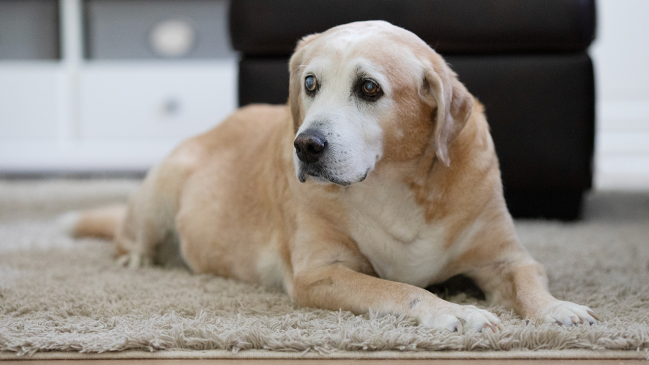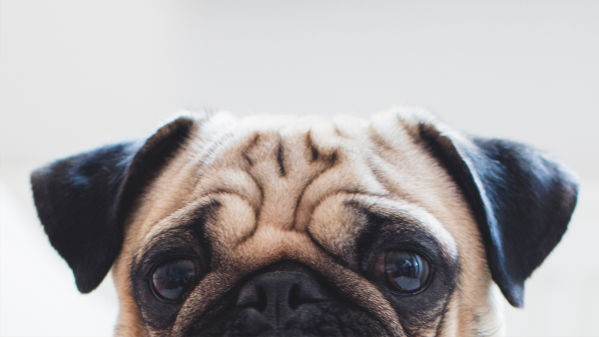The thought of your dog losing all or some of its vision might seem a bit intimidating or scary — what will their life be like now that they can no longer see, and how will you take care of your newly blind dog? The good news is there are resources in place to make the transition for you and your dog relatively easy. Read on to learn more about what may cause your dog to lose their vision and what you can do to care for your blind dog.
That's why Pawp has reached out to a veterinary ophthalmologist about the signs and symptoms of your dog going blind, what causes blindness in dogs, and how you can help care for your blind dog. Check out what the experts have to say.
Signs your dog is going blind
You may notice some new behavior from your dog if they’re going blind. “The most common sign would be bumping into stationary objects,” Dr. DJ Haeussler, a Board Certified Veterinary Ophthalmologist at The Animal Eye Institute, tells Pawp. “Other signs could be that the dog used to catch things from mid-air and no longer is able to do so.”
There are other clues that your dog’s vision may be worsening, even if they’re not completely blind yet. According to Dr. Haeussler, your pup may seem less confident in getting around in lower light levels, for example, if they’re gradually losing their eye sight.
Other symptoms of blindness in dogs include:
Cloudy eyes
Bumping into things
Less confidence in new environments
Non-dilated pupils
Pawing at face
White spots or swelling around the eyes
Less eye contact
Heightened anxiety
What causes blindness in dogs?
Some common causes of blindness in dogs include, but are not limited to, the following:
Sudden Acquired Retinal Degeneration (SARD)
Many things can cause sudden blindness in dogs. One common trait is Sudden Acquired Retinal Degeneration (SARD), where a pup experiences sudden, and usually permanent, blindness. Certain breeds are prone to this condition, including Dachshunds and Miniature Schnauzers. The good news is that the condition isn’t painful for your pup, even though their sight is gone.
Injury or head wound
A blow to the head or eye specifically may be the cause of blindness in dogs depending on the severity of the trauma and exactly where on the dog's body it occurs.
Immune-mediated retinal detachment syndrome
Another cause of sudden dog blindness is immune-mediated retinal detachment syndrome. Middle aged and senior dogs are prone to this condition where their retinas detach from their eyes. The good news here is that it again isn’t painful for your pup, and there are treatments that can potentially reverse the disease.
Cataracts
Cataracts, where the composition of an eye’s lens becomes cloudy or otherwise disrupted, are also a cause of dog blindness.
Diabetes
Dogs that have diabetes may be more prone to cataracts and full blindness, though your pup’s genes may also make them more susceptible.
Progressive retinal atrophy
Your dog going blind, however, might not be a sudden thing — progressive retinal atrophy, for example, can cause gradual blindness in your pup. This condition can happen early or late in life and causes the photoreceptor cells in the eye to deteriorate or develop abnormally. According to Dr. Haeussler, this condition is inherited and starts with the dog losing vision in low light. As the condition progresses, it causes a dog to lose vision in well-lit areas as well.

How to care for a blind dog
The good news is that with a few tweaks to how you care for your dog, your pup will still be able to live a happy and fulfilling life. “Blind dogs can do quite well as they utilize their other senses,” Dr. Haeussler explains, adding that many owners might find that they dogs get comfort from hearing your voice regularly as their eyesight deteriorates.
Buy a bumper
The routine of a blind dog typically doesn’t need to change drastically, but there are certain products that can help make things easier for you and your pup. “Some owners may prefer to purchase a ‘bumper’ for their dog;” Dr. Haeussler says, “this looks kind of like a small hula hoop that goes in front of the dog's head so that it contacts objects before the dog hits his/her head.”
Protect dangerous areas with baby gates
Other products that can make your house safe for your blind dog are baby gates in front of steps to make sure your pup doesn’t stumble down them. Owners should also be extra careful about keeping walkways clear of objects the blind pup won’t be able to see.
Read More: Blind Cats — Signs, Causes & How To Care For Them
Keep your furniture in the same position
If possible, it’s also good to not rearrange your furniture too much, as your blind pup won’t be able to see those changes.
Try dog toys specifically made for blind dogs
There are also dog toys specifically made for blind dogs, though any toy with a squeaker will still be very exciting for them.
Put bells on other pets' collars
If you have other dogs, it might be helpful to put a bell on their collar so their blind family member will easily know where they are.
Work on some clicker training
You can also use clicker training to teach your blind dog commands like “watch” when something might be in their way or “step” when there’s a step in front of them.
Keep close watch over your blind dog
Blind dogs also need special considerations when taken out of doors. “A blind dog should never be left outside in a non-fenced area by themselves,” says Dr. Haeussler. “It would also be beneficial to put up a fence around the yard as well as fence off any bodies of water such as pools, creeks, ponds, and lakes.
Have patience and show love
These are some considerations and changes you’ll have to make to accommodate your blind best friend, but soon you and your pup will adjust to their new condition and be happy as can be.
